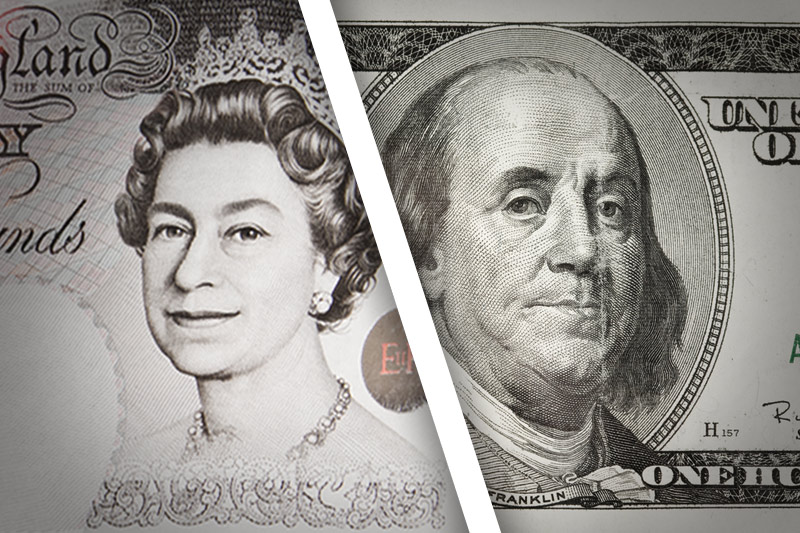Investing.com - The pound remained lower against the U.S. dollar on Thursday, as market sentiment remained pressured by fresh concerns over the outlook for global economic growth in the euro zone, while strong U.S. data supported demand for the greenback.
GBP/USD hit 1.5606 during U.S. morning trade, the daily low; the pair subsequently consolidated at 1.5626, falling 0.19%.
Cable was likely to find support at 1.5545, the low of August 6 and resistance at 1.5729, the high of July 31.
Market sentiment weakened after the European Central Bank said in its monthly bulletin that the economic outlook for the euro zone faced a number of downside risks, with financial market tensions and their potential impact on growth posing the key threats.
The ECB revised down its forecast for economic growth to 0.6% in 2013, down from 1% previously and forecast a 0.3% contraction in growth this year, slightly worse than its previous forecast of for a 0.2% contraction.
In addition, optimism that the ECB will soon move to lower high Spanish and Italian borrowing costs seemed to fade as investors waited for more details of the bank’s proposed bond buying program to emerge.
Sterling also came under pressure after official data showed earlier that the U.K. trade deficit widened more-than-expected in June, hitting GBP10.1 billion from a deficit of GBP8.4 billion the previous month.
Analysts had expected the U.K. trade deficit to widen to GBP8.6 billion in June.
The data came one day after the Bank of England said that the U.K. economy would barely grow this year and cut its forecasts for the coming years in its quarterly inflation report.
Meanwhile, the greenback strengthened as upbeat U.S. economic reports dampened expectations for fresh stimulus measures by the Federal Reserve in the near future.
Official data showed that the U.S. trade deficit narrowed more-than-expected in June, dropping to USD42.9 billion from a deficit of USD48.0 billion the previous month.
Analysts had expected the trade deficit to narrow to USD47.4 billion in June.
Separately, the Department of Labor said the number of people who filed for unemployment assistance in the U.S. declined to 361,000 last week, from an upwardly revised 367,000 in the previous week, against expectations for an increase to 370,000.
Elsewhere, the pound was higher against the euro with EUR/GBP shedding 0.32%, to hit 0.7872.
Also Thursday, data showing that China's annual consumer inflation fell to a 30-month low in July added to speculation that the country’s central bank may implement further monetary easing.
GBP/USD hit 1.5606 during U.S. morning trade, the daily low; the pair subsequently consolidated at 1.5626, falling 0.19%.
Cable was likely to find support at 1.5545, the low of August 6 and resistance at 1.5729, the high of July 31.
Market sentiment weakened after the European Central Bank said in its monthly bulletin that the economic outlook for the euro zone faced a number of downside risks, with financial market tensions and their potential impact on growth posing the key threats.
The ECB revised down its forecast for economic growth to 0.6% in 2013, down from 1% previously and forecast a 0.3% contraction in growth this year, slightly worse than its previous forecast of for a 0.2% contraction.
In addition, optimism that the ECB will soon move to lower high Spanish and Italian borrowing costs seemed to fade as investors waited for more details of the bank’s proposed bond buying program to emerge.
Sterling also came under pressure after official data showed earlier that the U.K. trade deficit widened more-than-expected in June, hitting GBP10.1 billion from a deficit of GBP8.4 billion the previous month.
Analysts had expected the U.K. trade deficit to widen to GBP8.6 billion in June.
The data came one day after the Bank of England said that the U.K. economy would barely grow this year and cut its forecasts for the coming years in its quarterly inflation report.
Meanwhile, the greenback strengthened as upbeat U.S. economic reports dampened expectations for fresh stimulus measures by the Federal Reserve in the near future.
Official data showed that the U.S. trade deficit narrowed more-than-expected in June, dropping to USD42.9 billion from a deficit of USD48.0 billion the previous month.
Analysts had expected the trade deficit to narrow to USD47.4 billion in June.
Separately, the Department of Labor said the number of people who filed for unemployment assistance in the U.S. declined to 361,000 last week, from an upwardly revised 367,000 in the previous week, against expectations for an increase to 370,000.
Elsewhere, the pound was higher against the euro with EUR/GBP shedding 0.32%, to hit 0.7872.
Also Thursday, data showing that China's annual consumer inflation fell to a 30-month low in July added to speculation that the country’s central bank may implement further monetary easing.
